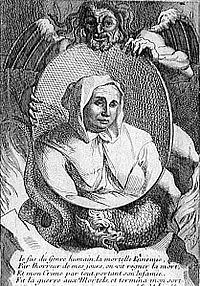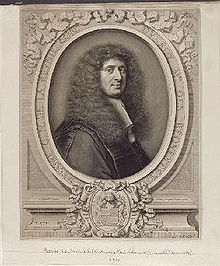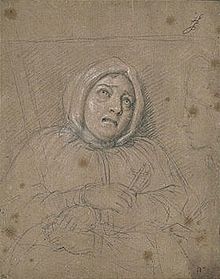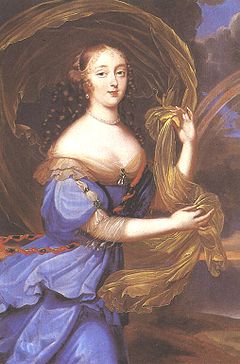
Poison affair
Encyclopedia




Murder
Murder is the unlawful killing, with malice aforethought, of another human being, and generally this state of mind distinguishes murder from other forms of unlawful homicide...
scandal in France
France
The French Republic , The French Republic , The French Republic , (commonly known as France , is a unitary semi-presidential republic in Western Europe with several overseas territories and islands located on other continents and in the Indian, Pacific, and Atlantic oceans. Metropolitan France...
which took place in 1677–1682, during the reign of King Louis XIV
Louis XIV of France
Louis XIV , known as Louis the Great or the Sun King , was a Bourbon monarch who ruled as King of France and Navarre. His reign, from 1643 to his death in 1715, began at the age of four and lasted seventy-two years, three months, and eighteen days...
. During it, a number of prominent members of the aristocracy were implicated and sentenced on charges of poison
Poison
In the context of biology, poisons are substances that can cause disturbances to organisms, usually by chemical reaction or other activity on the molecular scale, when a sufficient quantity is absorbed by an organism....
ing and witchcraft
Witchcraft
Witchcraft, in historical, anthropological, religious, and mythological contexts, is the alleged use of supernatural or magical powers. A witch is a practitioner of witchcraft...
. The scandal reached into the inner circle of the king.
Context and origin
The origin of the case began in 1675 after the trial of Marie-Madeleine-Marguerite d'Aubray, Marquise de BrinvilliersMarie-Madeleine-Marguerite d'Aubray, Marquise de Brinvilliers
Marie-Madeleine-Marguerite d'Aubray, Marquise de Brinvilliers was a French serial killer.-Crimes:Marie-Madeleine-Marguerite d'Aubray conspired with her lover, army captain Godin de Sainte-Croix to poison her father Antonine Dreux d'Aubray in 1666 and two of her brothers, Antoine d'Aubray and...
, who had conspired with her lover, army captain Godin de Sainte-Croix, to poison her father Antonine Dreux d'Aubray in 1666 and two of her brothers, Antoine d'Aubray and Francois d'Aubray, in 1670, in order to inherit their estates. There were also rumors that she had poisoned poor people during her visits in hospitals. She fled but was arrested in Liège. She was forced to confess, sentenced to death and on July 17 was tortured with the water cure
Water cure (torture)
Water cure as a term for a form of torture refers to a method in which the victim is forced to drink large quantities of water in a short time, resulting in gastric distension, water intoxication and possibly death....
(forced to drink sixteen pints of water), beheaded and burned at the stake
Burned at the Stake
Burned at the Stake is a 1981 film directed by Bert I. Gordon. It stars Susan Swift and Albert Salmi.-Cast:*Susan Swift as Loreen Graham / Ann Putnam*Albert Salmi as Captaiin Billingham*Guy Stockwell as Dr. Grossinger*Tisha Sterling as Karen Graham...
. Her accomplice Sainte-Croix had died of natural causes in 1672.
The sensational trial drew attention to a number of other mysterious deaths, starting a number of rumours. Prominent people, including Louis XIV, became alarmed that they also might be poisoned. The King forced some of his servants to become his foretaster
Food taster
A food taster is a person that takes food to be served to someone else to confirm that it is safe to eat and does not contain toxins or poisons. The person to whom the food is going to be served is usually an important person, like an emperor or monarch, or anyone that could possibly be under...
s.
Implications and investigation
The affair proper opened in February 1677 after the arrest of Magdelaine de La GrangeMagdelaine de La Grange
Magdelaine de La Grange was a French fortune-teller involved in the Affair of the Poisons. Her arrest in 1677 marked the opening of the official investigation. She appealed to François-Michel le Tellier, Marquis de Louvois claiming that she had information about other crimes of high importance...
on charges of forgery and murder. La Grange appealed to François-Michel le Tellier, Marquis de Louvois
François-Michel le Tellier, Marquis de Louvois
François Michel Le Tellier, Marquis de Louvois was the French Secretary of State for War for a significant part of the reign of Louis XIV. Louvois and his father, Michel le Tellier, would increase the French Army to 400,000 soldiers, an army that would fight four wars between 1667 and 1713...
claiming that she had information about other crimes of high importance. Louvois reported to the King, who told Gabriel Nicolas de la Reynie
Gabriel Nicolas de la Reynie
Gabriel Nicolas de la Reynie is considered to be the founder of the first modern police force.-Early career:Born in 1625 in Limoges, France to a poor family, Gabriel Nicolas made a wealthy marriage in 1645 and took the name of Reynie, a minor lordship with an annual income of 200 pounds. He was a...
, who, among other things, was the chief of the Paris police, to root out the poisoners. La Reynie sought to calm the King. The subsequent investigation of potential poisoners was to lead to accusations of witchcraft, murder and more.
Authorities rounded up a number of fortune-tellers
Divination
Divination is the attempt to gain insight into a question or situation by way of an occultic standardized process or ritual...
and alchemists
Alchemy
Alchemy is an influential philosophical tradition whose early practitioners’ claims to profound powers were known from antiquity. The defining objectives of alchemy are varied; these include the creation of the fabled philosopher's stone possessing powers including the capability of turning base...
that were suspected of selling not only divination
Divination
Divination is the attempt to gain insight into a question or situation by way of an occultic standardized process or ritual...
s, séance
Séance
A séance is an attempt to communicate with spirits. The word "séance" comes from the French word for "seat," "session" or "sitting," from the Old French "seoir," "to sit." In French, the word's meaning is quite general: one may, for example, speak of "une séance de cinéma"...
s and aphrodisiac
Aphrodisiac
An aphrodisiac is a substance that increases sexual desire. The name comes from Aphrodite, the Greek goddess of sexuality and love. Throughout history, many foods, drinks, and behaviors have had a reputation for making sex more attainable and/or pleasurable...
s, but also "inheritance powders" (aka: poison). Some of them under torture confessed and gave the authorities lists of their clients, who had allegedly bought poison to either get rid of their spouses or rivals in the royal court.
The most famous case was of the midwife Catherine Deshayes Monvoisin
Catherine Monvoisin
Catherine Monvoisin, née Deshayes, known as "La Voisin" , was an French alleged sorceress, one of the chief personages in the affaire des poisons, during the reign of Louis XIV.- Activity :...
or La Voisin, who was arrested in 1679 after having been pointed out by the poisoner Marie Bosse. La Voisin implicated a number of important individuals in the French court. These included Olympe Mancini, the Comtesse de Soissons, her sister Marie Anne Mancini
Marie Anne Mancini
Marie Anne Mancini, duchesse de Bouillon , was the youngest of the five famous Mancini sisters, who along with two of their female Martinozzi cousins, were known at the court of King Louis XIV of France as the Mazarinettes because their uncle was the king's chief minister, Cardinal...
Duchesse de Bouillon, François Henri de Montmorency-Bouteville, duc de Luxembourg
François Henri de Montmorency-Bouteville, duc de Luxembourg
François Henri de Montmorency-Bouteville, duc de Piney, called de Luxembourg was a French general, marshal of France, famous as the comrade and successor of the great Condé.-Early years:...
and, most importantly, the King's mistress, the Marquise de Montespan
Françoise-Athénaïs, marquise de Montespan
Françoise Athénaïs de Rochechouart de Mortemart, marquise of Montespan , better known as Madame de Montespan, was the most celebrated maîtresse en titre of King Louis XIV of France, by whom she had seven children....
.
Being questioned while she was kept intoxicated, La Voisin claimed that de Montespan had bought aphrodisiacs and performed black mass
Black Mass
A Black Mass is a ceremony supposedly celebrated during the Witches' Sabbath, which was a sacrilegious parody of the Catholic Mass. Its main objective was the profanation of the host, although there is no agreement among authors on how hosts were obtained or profaned; the most common idea is that...
es with her in order to gain and keep the King's favor over other rival lovers. She had worked with a priest named Etienne Guibourg
Étienne Guibourg
The Abbé Étienne Guibourg was a French Roman Catholic abbé who was involved in the Affair of the Poisons.He was the sacristan of the Saint-Marcel church at Saint-Denis, and formerly the chaplain to the Comte de Montgomery. He claimed to be the illegitimate son of Henri de Montmorency...
. There was no evidence beyond her confessions, but the bad reputation followed these people afterwards. Eleanor Herman, on page 113 in her book Sex With Kings, records "Given" claimed the remains of 2500 infants were found in La Voisin's garden. But Anne Somerset disputes this in her book The Affair of the Poisons and states there is no mention of the garden being searched for human remains.
Also involved in the scandal was Eustache Dauger de Cavoye, the eldest living son of a prominent noble family. De Cavoye was disinherited by his family when, in an act of debauchery he chose to celebrate Good Friday with a black mass. Upon being disinherited he opened a lucrative trade in "inheritance powder
Arsenic
Arsenic is a chemical element with the symbol As, atomic number 33 and relative atomic mass 74.92. Arsenic occurs in many minerals, usually in conjunction with sulfur and metals, and also as a pure elemental crystal. It was first documented by Albertus Magnus in 1250.Arsenic is a metalloid...
s" and aphrodisiacs. He mysteriously disappeared after the abrupt ending to Louis's official investigation in 1678. Because of this, and his name he was once suspected of being The Man in the Iron Mask
Man in the Iron Mask
The Man in the Iron Mask is a name given to a prisoner arrested as Eustache Dauger in 1669 or 1670, and held in a number of jails, including the Bastille and the Fortress of Pignerol . He was held in the custody of the same jailer, Bénigne Dauvergne de Saint-Mars, for a period of 34 years...
. However this theory has fallen out of favor because it is known that he was imprisoned by his family in 1679 in the Prison Saint-Lazare
Prison Saint-Lazare
The Prison Saint-Lazare was a prison in the Xe arrondissement of Paris, France.-History:Originally a leper hospital founded on the road from Paris to Saint-Denis at the boundary of the marshy area of former Seine river bank in the 12th century, it was ceded on 7 January 1632 to Vincent de Paul and...
.
The end of the trial
La Voisin was sentenced to death for witchcraft and poisoning, and burned at the stake on February 22, 1680. Marshal Montmorency-Bouteville was briefly jailed in 1680, but was later released and became a captain of the guard. Minister Jean-Baptiste ColbertJean-Baptiste Colbert
Jean-Baptiste Colbert was a French politician who served as the Minister of Finances of France from 1665 to 1683 under the rule of King Louis XIV. His relentless hard work and thrift made him an esteemed minister. He achieved a reputation for his work of improving the state of French manufacturing...
helped to hush things up.
De La Reynie re-established the special court, the Chambre Ardente
Chambre Ardente
A Chambre ardente was an extraordinary court of justice in Ancien Régime France, mainly held for the trials of heretics.The name is perhaps an allusion to the fact that the proceedings took place in a room from which all daylight was excluded, the only illumination being from torches, or there may...
("burning court") to judge cases of poisoning and witchcraft. It investigated a number of cases, including many connected to nobles and courtiers in the King's court. Over the years the court sentenced 34 people to death for poisoning or witchcraft. Two died under torture and several courtiers were exiled. The court was abolished in 1682, because the King could not risk publicity of such scandal. To this, Police Chief Reynie said, "the enormity of their crimes proved their safeguard."
Aftermath
Perhaps the most important effect of the scandal, and subsequent persecutions, was the expulsion from France of the aforementioned Comtesse de Soissons. Her son remained in France only to find that his mother's high-profile disgrace prevented him from realising his personal ambitions, as he was effectively barred from pursuing a military career. He would eventually leave France nurturing a profound grudge against Louis XIV and enter the service of France's sworn enemies the Habsburgs. Prince Eugene of SavoyPrince Eugene of Savoy
Prince Eugene of Savoy , was one of the most successful military commanders in modern European history, rising to the highest offices of state at the Imperial court in Vienna. Born in Paris to aristocratic Italian parents, Eugene grew up around the French court of King Louis XIV...
, or Prinz Eugen, would, in time, come to be known as one of the greatest generals of the age and one of the factors behind the failure of Louis' bid for hegemony in Europe.
Text
- Lynn Wood Mollenauer - Strange Revelations: Magic, Poison, and Sacrilege in Louis XIV’s France. [Magic in History Series.] (University Park: Pennsylvania State University Press. 2007.
- Anne Somerset - The Affair of the Poisons: Murder, Infanticide, and Satanism at the Court of Louis XIV (St. Martin's Press (October 12, 2003) ISBN 0-312-33017-0)
- Éric Le Nabour - La Reynie: Le policier de Louis XIV (Présence de lhistoire) (Perrin (1990) ISBN 978-2262008062)
- Judith Merkle Riley - The Oracle Glass (Fiction)
- Frances Mossiker - The Affair of the Poisons: Louis XIV, Madame de Montespan, and one of History's great Unsolved Mysteries (Alfred A. Knopf (1969) ISBN 0722162456) -
- François Ravaisson - Archives de la Bastille (Paris, 1866-1884, volumes IV, V, VI, VII)
- Excerpts from Bastille trial records of Guibourg and LaVoisin (French and English translation)
- Karen Charbonneau - "The Wolf's Sun" (Ship's Cat Books (2010)http://www.amazon.com/dp/B004D4Y5GE?m=AG56TWVU5XWC2
Video
- Royal Secrets - Volume 2: Madmen / Murderers / Sorcery / Warmongers (VHS)

